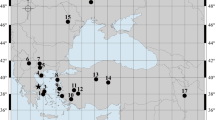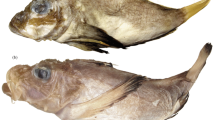Abstract
Intraspecific variation of the gross morphology of the retractor muscle was studied in 60 specimens of Parathyone braziliensis and 17 specimens of Thyonidium seguroensis. Specimens were dissected to expose the retractor muscle or were analyzed by micro-computed tomography. Early expectations that the point of origin of the retractor muscle at the longitudinal muscle relative to the midpoint of the body length was age-related and that the split of the retractor muscle into separate muscle bands could be used as taxonomic characters to separate species were not supported by anatomical evidence.



Similar content being viewed by others
Data Availability
All data generated or analysed during this study are included in this published article.
References
Cherbonnier G (1970) Nouvelles especes d’holothuries des cotes d’Afrique du sud et du Mozambique. Bull Mus Natl Hist Nat 42(1):280–299
Cuvier GL (1817) Le règne animal distribué d'après son organisation: pour servir de base a l'histoire naturelle des animaux et d'introduction a l'anatomie comparée 4. Les Zoophytes
Deichmann E (1930) The holothurians of the western part of the Atlantic Ocean. Mem Mus Comp Zool Harvard Coll 71(3):1–226
Gunnerus JE (1767) Beskrifning på trenne Norrska Sjö-Kråk, Sjö-Pungar kallade. Kungl. Svenska Vetenskapsakademiens Handlingar 28:114–124
Heding SG, Panning A (1954) Phyllophoridae: Eine Bearbeitung der Polytentaculaten Dendrochiroten Holothurien des Zoologischen Museums in Kopenhagen. Spolia Zoologica Musei Hauniensis 13:7–209
Heffernan JM, Wainwright SA (1974) Locomotion of the holothurian Euapta lappa and redefinition of peristalsis. Biol Bull 1:95–104. https://doi.org/10.2307/1540571
Hendler G, Miller JE, Pawson DL, Kie PM (1995) Sea stars, sea urchins, and allies: Echinoderms of Florida and the Caribbean. Smithsonian Institution Press, Washington, DC
Hyman LH (1955) The invertebrates: Echinodermata. McGraw-Hill Book Co., Inc.; New York, The coelome Bilateria
Kroh A, Gaudin J, Reich M (2022) Oloughlinia, a replacement name for Clarkiella Heding in Heding & Panning, 1954 (Echinodermata: Holothuroidea: Sclerodactylidae). Zootaxa 5178(4):397–399
Ludwig H (1889–1892) Die Seewalzen. In Bronn HG (Ed.), Klassen und Ordnungen des Thier-Reichs, wissenschaftlich dargestellt in Wort und Bild. Part 3: Echinodermen (Stachelhäuter). First book. 2 Leipzig: C. F. Winter, pp 1–176
Martins L (2019) Ontogenetic variation of the ossicles in Pseudothyone belli (Ludwig, 1887) with a description of a new Sclerodactylidae (Echinodermata: Holothuroidea: Dendrochirotida) from Southwestern Atlantic. Mar Biol Res 15(7):434–443
Martins L, Tavares M (2018a) A new genus and species of Sclerodactylidae (Echinodermata: Holothuroidea: Sclerothyoninae) from the Pacific coast of Panama, and assignment of Neopentamera anexigua to Sclerothyoninae. Zootaxa 4429(1):157–164. https://doi.org/10.11646/zootaxa.4429.1.8
Martins L, Tavares M (2018b) New species of the genera Havelockia and Thyone (Echinodermata: Holothuroidea) and first record of T. crassidisca from the southwestern Atlantic Ocean. Zootaxa 4407(4):553–542. https://doi.org/10.11646/zootaxa.4407.4.5
Martins L, Souto C (2019) Taxonomic remarks on Havelockia and Thyone (Echinodermata: Holothuroidea: Dendrochirotida), with descriptions of two new species from the Brazilian coast. J Mar Biolog Assoc UK 99(5):1127–1134. https://doi.org/10.1017/S0025315418001078
Martins L, Tavares M (2019) Two new species of Sclerothyone from the southwestern Atlantic Ocean, with a key to genera and species of Sclerothyoninae (Holothuroidea: Dendrochirotida: Sclerodactylidae). Zootaxa 4658(2):375–382. https://doi.org/10.11646/zootaxa.4658.2.11
Martins L, Souto C, Tavares M (2021) Exploring the macrostructural anatomy of dendrochirotid sea cucumber’s (Echinodermata) calcareous rings under micro-computed tomography and its bearing on phylogeny. J Anat 238(6):1386–1403. https://doi.org/10.1111/joa.13385
Martins L, Tavares M (2022) Additions to the morphology of the Phyllophoridae and the Sclerodactylidae. I. Type species of Phyllophorella, Selenkiella, Cladolella and Clarkiella, with the description a new species of Thorsonia (Holothuroidea: Dendrochirotida). Zootaxa 5120(4):559–572. https://doi.org/10.11646/zootaxa.5120.4.6
Metscher BD (2011) X-Ray microtomographic imaging of intact vertebrate embryos. Cold Spring Harbor Protocols 1462–1471. https://doi.org/10.1101/pdb.prot067033
Thandar AS (1998) A new genus and three new species of deep-sea holothuroids from the west coast of South Africa (Echinodermata). J Zool Lond 244:79–88
Thandar AS (2001) The holothuroid family Rhopalodinidae – its composition, distribution, phylogeny and taxonomic status. Afr Zool 6(2):229–243
Verrill AE (1868) Notes on the Radiata in the Museum of Yale College, with descriptions of new genera and species, 4. Notice of the corals and Echinoderms collected by Prof. C.F. Hartt, at the Abrolhos Reefs, Province of Bahia, Brazil, 1867. Trans Conn Acad Arts Sci 1:247–613. https://doi.org/10.1086/270248
Acknowledgements
We are grateful to Alberto Carvalho Laboratório Multiusuário de Processamento de Imagens de Microtomografia Computadorizada de Alta Resolução (MZUSP) for generation of μCT images. We are grateful to Wagner Magalhães (UFBA) for granting access to the museum collections under their responsibility and for logistical support.
Funding
This study was financed in part by the Coordenação de Aperfeiçoamento de Pessoal de Nível Superior – Brasil (CAPES) – Finance Code 001 (PNPD 88887.368621/2019‑00 to LM) and grant #2021/06442-1, São Paulo Research Foundation (FAPESP) to LM. MT thanks CNPq (309488/2020‑6) for supporting studies on the systematics of marine invertebrates.
Author information
Authors and Affiliations
Contributions
LM conceived the idea. Material preparation, data collection and analysis were performed by LM. The first draft of the manuscript was written by LM. All authors writing – review & editing and participated in the discussion of the results.
Corresponding author
Ethics declarations
Ethical Approval
Not applicable.
Human and Animal Ethics
Not applicable.
Consent for Publication
All authors agree with the publication of this article.
Conflict of Interest
The authors declare that no competing interests exist regarding this paper.
Additional information
Publisher's Note
Springer Nature remains neutral with regard to jurisdictional claims in published maps and institutional affiliations.
Rights and permissions
Springer Nature or its licensor (e.g. a society or other partner) holds exclusive rights to this article under a publishing agreement with the author(s) or other rightsholder(s); author self-archiving of the accepted manuscript version of this article is solely governed by the terms of such publishing agreement and applicable law.
About this article
Cite this article
Martins, L., Tavares, M. Additions to the Morphology of the Cucumariidae. I. Intraspecific Variation of the Retractor Muscle in Parathyone braziliensis (Verrill, 1868) and Thyonidium seguroensis (Deichmann, 1930) (Holothuroidea: Dendrochirotida). Thalassas 39, 405–412 (2023). https://doi.org/10.1007/s41208-022-00515-4
Received:
Revised:
Accepted:
Published:
Issue Date:
DOI: https://doi.org/10.1007/s41208-022-00515-4




